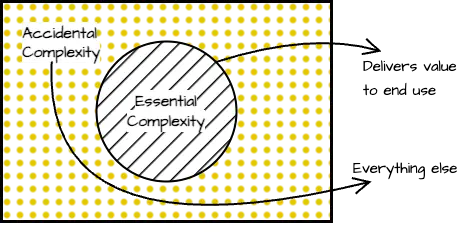Posted on 28 Jan 2025
All software systems are inherently complex. Essential complexity is attributed to the business requirement, and
incidental complexity is attributed to everything else. I wrote a blog
Complexity in Software Engineering explaining types of complexity and how they arise (I would highly
recommend reading this article to familiarise with the fundamentals). Once you've grasped the basics, the real
fun begins - managing complexity. In the race to deliver features, how do we ensure we are adding necessary
complexity which allows the system to sustainably evolve and not come to a screeching halt. Let's dive into
principles to manage complexity in software systems both within your code.

Posted on 05 Jan 2025
The word "complex" when used as an adjective, implies "consisting of many different and connected parts" and
when used as a noun implies "a group or system of different things that are linked in a close or complicated
way; a network". Ant colonies, nervous system, public transportation systems of a country and software systems
are examples of complex systems. The common denominator in all these examples is the interconnected nature of
their parts. The reason for the interconnected nature of these systems is to deliver value. Complex systems
allow the distribution of tasks and responsibilities among its parts. Ant colonies leverage the complex nature for
survival, achieved through the division of labour among the ants - such as finding food, maintaining the
colony, and protecting the queen. The nervous system is a complex network of nerves and cells that allow your
body to conduct various functions by carrying signals and messages to and from the brain to organs. Public
transportation systems are complex networks of buses, trains, and trams that allow people and goods to move from
point A to point B. Software systems are complex networks of code, data and infrastructure that allows a
business or an organisation to deliver value to the user of their products.
Posted on 28 Aug 2024
DRY aka "Don't Repeat Yourself" was first coined in the book
Pragmatic Programmer by Andrew Hunt and David Thomas. Here is the
snippet from the book explaining the principle:
Every piece of knowledge must have a single, unambiguous, authoritative representation within a system.
Why do we call it DRY?
DRY—Don't Repeat Yourself
"Don't Repeat Yourself" is just a short and punchy statement so it sticks around in the head. The principle is
based on three clear callouts: Single, Unambiguous, and Authoritative.
DAMP aka "Descriptive And Meaningful Phrases",
was coined by Jay Fields. He
published a blog post comparing the two approaches and proposing that DAMP is required in scenarios where you
are working with DSL. I want to widen the lens here a bit and propose that they are complimentary. DAMP
emphasises being descriptive and meaningful, so does DRY on being unambiguous. Focusing on the intent they both
want the intent of the outcome clear and self-explanatory.
Posted on 31 Jul 2024
I have been working on an internal firm CLI recently. This is written in dotnet 8, and I am using
Spectre
Console. Coincidence that I was writing my blog about
My TDD Pilgrimage, and I was hitting rock bottom trying to
test code I was adding in my
Program.cs. What an irony. As I started asking around and also doing
my research in parallel I came across the following 2 links:
The links above provide comprehensive information about the humble object. Inspired by this, I rolled up my
sleeves and started refactoring my code to make it more testable. Follow along as I first explain the pattern
and then demonstrate, through a simple example, how you can refactor your own code to enhance testability.
Together, we'll break down each step, making this concept easy to grasp and implement in your own projects.
Posted on 15 Jul 2024
In 2010, I was working at a startup and a colleague did a show-and-tell about unit tests. It was my first job, I
had never seen unit tests before, and in all honestly, I completely disliked it. Initially, thought it was a
waste of time. Today in 2024, I have a very unsettling feeling if I end up writing a code without writing tests
first. I have always wondered why I had an allergic reaction at the beginning and why it took me the time it did
to warm up to this practice. So I started to roadmap key milestones I had in the last 14 years and the agents
that brought about this change for me.
Posted on 22 May 2024
As a software engineer, we are continuously learning and growing. With learning and growing, progress follows.
Progress comes in the form of promotions, new roles and responsibilities, and sometimes even a change in the domain.